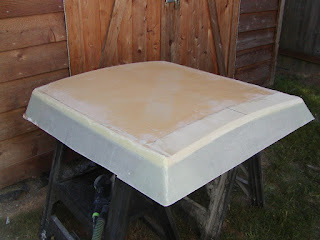The poptop hatch got an extra layer of A around the top outside edges:

I'm debating whether to put an extra layer of A on the top part. I also have collected all of the raw materials to start assembling the poptop hatch mechanicals (aluminum bars, bolts\nuts, plastic, jib track & slides, etc). I will start on that part of the project as soon as I have finished up most of the smaller jobs going on.
Yesterday I finally finished painting the cockpit compartment interiors; it took me all week to finally get down to 400 grit (yeah right). The weather has been crazy-hot lately, and it was a few degrees above System Three's suggested max temp for paint application. I compensated by thinning the paint with some slightly chilled water. I think it turned out ok:
 Definitely a "work boat" finish, but plenty good enough for me. Here's another view in better light:
Definitely a "work boat" finish, but plenty good enough for me. Here's another view in better light:
 Here's the strategy I came up with to glue the settee stiffeners at a nice square angle to the settees:
Here's the strategy I came up with to glue the settee stiffeners at a nice square angle to the settees:  The fwd-most clamp does not have a piece of wood, since I didn't think I'd be able to get the screw out once the stiffener was glued in place. Here's a cross-section of one of these stiffeners:
The fwd-most clamp does not have a piece of wood, since I didn't think I'd be able to get the screw out once the stiffener was glued in place. Here's a cross-section of one of these stiffeners:
 I over-built the stiffeners a bit; two layers of A on each side, then the layer of A around the bottom curved edge, then another layer of A on the top edge (after routing a nice curve onto the front edge):
I over-built the stiffeners a bit; two layers of A on each side, then the layer of A around the bottom curved edge, then another layer of A on the top edge (after routing a nice curve onto the front edge):
 Eventually after I flip the hull upside down, I'll use A tape along the bottom inside join. So far, the results are quite satisfying: the settees have become nearly rock-solid places to sit. I am still however at a loss as to whether I should enclose the space beneath or not; rather than torture myself further, I decided to just leave the settees as-is for now. (With the limited space in that area, I shudder to think about if\how I'm going to fair the area fwd of the daggerboard case...)
Eventually after I flip the hull upside down, I'll use A tape along the bottom inside join. So far, the results are quite satisfying: the settees have become nearly rock-solid places to sit. I am still however at a loss as to whether I should enclose the space beneath or not; rather than torture myself further, I decided to just leave the settees as-is for now. (With the limited space in that area, I shudder to think about if\how I'm going to fair the area fwd of the daggerboard case...)
With the compartments painted, I was finally free to glue the seats on:
 Not shown in the above picture, but the initial perimeter taping on top of the seats has been done as well. I also dug out the foam from the extra layer on the aft-cabin hatch and filled it with bog (man I hate that job).
Not shown in the above picture, but the initial perimeter taping on top of the seats has been done as well. I also dug out the foam from the extra layer on the aft-cabin hatch and filled it with bog (man I hate that job).
Last but not least, I began making blanks for the settee backs.























